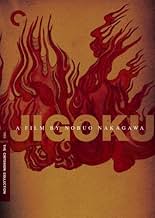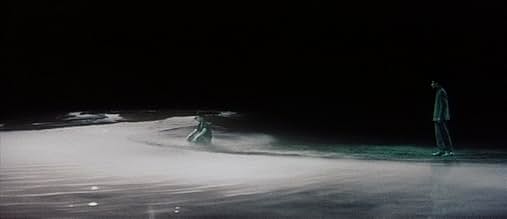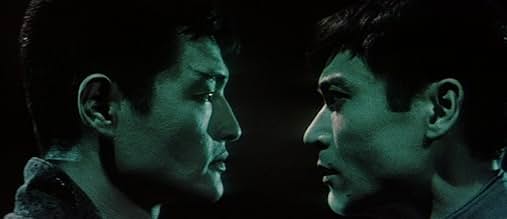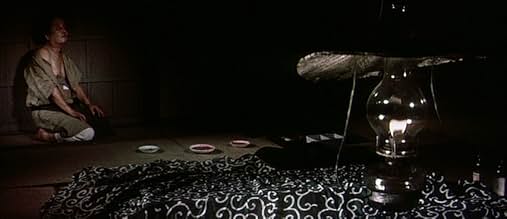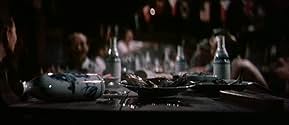अपनी भाषा में प्लॉट जोड़ेंA group of sinners involved in interconnected tales of murder, revenge, deceit and adultery all meet at the Gates of Hell.A group of sinners involved in interconnected tales of murder, revenge, deceit and adultery all meet at the Gates of Hell.A group of sinners involved in interconnected tales of murder, revenge, deceit and adultery all meet at the Gates of Hell.
- निर्देशक
- लेखक
- स्टार
- Professor Yajima
- (as Torahiko Nakamura)
फ़ीचर्ड समीक्षाएं
From the stylized approach (shooting from odd angles and the occasional adoption of a greenish hue) to its plethora of arresting imagery (especially the gruesome body piercing - sword through neck, eye-gouging, feet stamping on huge needles, torso sawed in half, etc.), director/co-writer Nakagawa's vision of Hell is surely among the most visceral ever depicted on the screen. While its concept of establishing sections (or circles) of punishment for specific crimes goes all the way back to Dante Alighieri - though, as mentioned in the film itself, Buddhism has its own take on the subject - cinematically it anticipates the one seen in the Coffin Joe outing THIS NIGHT I'LL POSSESS YOUR CORPSE (1966). Still, with respect to both the microcosmic viewpoint of the plot and the film's vivid color scheme, it also reminded me of GOKE - BODY SNATCHER FROM HELL (1968), while its essential nihilism (I literally lost count of the number of people killed off during the first hour!) looks forward to BLIND BEAST (1969).
The doppelganger element - in the DVD's main supplement, a 39-minute featurette, it's mentioned that the script was partly inspired by the Faust legend - heightens the film's already disquieting aura: Yoichi Numata as an emissary of Hell in human form (though he's not spared the painful retribution for his sins once the scene shifts to the netherworld) is especially effective; interestingly, the actor was disappointed by his own performance and admits now that he couldn't understand the role! However, I need to point out that - much like I had written of Ingmar Bergman's THE RITE (1969) - the plot reaches a level of implausible melodrama as to feel almost like a parody (even more so when considering the various characters' penchant for bursting into sentimental songs a' la the work of John Ford!).
Anyway, while I found the DVD transfer somewhat dark, I'm glad to say that the copy I own is the 'Second Pressing' - this means that the problem concerning a 2-minute sequence, which previously got skipped when watching the disc on a DVD player, has now been fixed. Originally intended for Eclipse, Criterion's sub-label - back when it was supposed to release little-known genre/exploitation titles - I feel that the film is important enough to warrant its place in the official Collection.
The bits from GHOST STORY OF YOTSUYA (1959) shown in the featurette were very intriguing and, hopefully, won't be too long in coming; still, I was equally itching to learn more about the various 'B' horror films by Nakagawa and production company Shintoho (which had actually started out by making such masterworks of World Cinema as Akira Kurosawa's STRAY DOG [1949] and Kenji Mizoguchi's THE LIFE OF OHARU [1952]!) whose posters form the extensive still gallery...
Although I have to admit that I'd never heard of the film prior to Criterion's DVD announcement, Chuck Stephens - in his rather pretentious essay in the accompanying booklet (though he perceptively suggests that the pairing of the dead yakuza's mother and girlfriend may well have anticipated the deadly female relatives of ONIBABA [1964]) - believes that JIGOKU ought to be thought of in the same terms as such horror landmarks as EYES WITHOUT A FACE (1959), BLACK Sunday (1960), PEEPING TOM (1960) and PSYCHO (1960), films which collectively brought an unprecedented maturity to the genre. Needless to say, the film's greatest influence can be seen in the gore-drenched Asian exploitation cinema which survives to this day (interestingly enough, JIGOKU was itself remade twice over the years - in 1979 and 1999!).
You realize that if you don't want to live in hell later, don't live in "hell" now.
A great psychedelic trip without psychedelic trappings.
For the first hour of this film we watch as our hero lives a life that is more or less a living hell. More horrible, terrible things befall him and those around him than anyone outside of a soap opera has a right to expect. Very act is bound to damn someone to hell and it isn't long before our guilt ridden hero crosses over and experiences what true torment is. Its enough to make you want to laugh were it not played so painfully straight.
What we see once we get to Hell itself looks great. Even some 40 years after it first marched across theater some of the shots of flayed flesh and disemboweled intestines are still shocking. The cramped and dark vistas are something out of a nightmare. Many tormented images you'd almost be proud to have on your walls.
Is it scary a bit but its not the be all and end all that some had made it out to be. Then again the films images have been raided by others so it less shocking. I also find that some of the pacing is off and what may have once worked now borders on tedious.
The film seems to be saying that all life, here or in the next world is miserable hellish and that no matter what we do we're doomed simply to suffer. A happy little film if there ever was one.
I like the film but far from love it. The first part is very soapy and over blown, while the second is almost a catalog of horrors. I give it points for trying but I don't think it completely works.
Should you see it?
A coin toss. It really depends on what you're looking for. If you're looking, for gore and guts, its here but not enough to make you walk away happy. Are you looking for a meditation on sin, guilt and existence, you may like it, especially if you can get past the soap. If you want to see a technically well made film that doesn't quite work but influenced later films and which will provide some discussion over dinner, then try it.
I give it 7 out of 10 for the parts more than the whole.
क्या आपको पता है
- ट्रिवियाThe film's production company was going out of business while the film was being completed, leading to budget-saving tactics such as the actors helping dig their own holes in the movie's set for Hell. Critics kidded that this film killed the Shintoho Studio.
- गूफ़While Shiro is on the rope bridge, we see him at various times hanging on to the side handrails. Between shots, without him having changed position, these handrails quite noticeably change in diameter from thin cables to a much thicker cable, indicating that some shots were filmed on a real bridge, others were filmed on a studio mock-up.
- भाव
Tamura: So you want to turn me in for manslaughter?
Shiro Shimizu: We're the ones who killed him. We caused it. Let's go together. Please.
Tamura: That might ease your conscience, but I'm not interested. It'd be stupid. He was drunk. He ran into the road. It was basically suicide. Besides, he was just some yakuza scum. He's not worth the best years of our lives.
- कनेक्शनFeatured in Building the Inferno: Nobuo Nakagawa and the Making of 'Jigoku' (2006)
- साउंडट्रैकComin' through the Rye
(uncredited)
Music: traditional
Japanese lyrics: unknown
टॉप पसंद
- How long is The Sinners of Hell?Alexa द्वारा संचालित
विवरण
- चलने की अवधि1 घंटा 41 मिनट
- पक्ष अनुपात
- 2.35 : 1
इस पेज में योगदान दें


